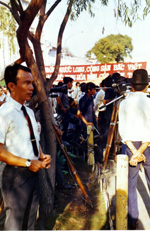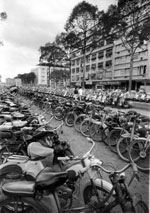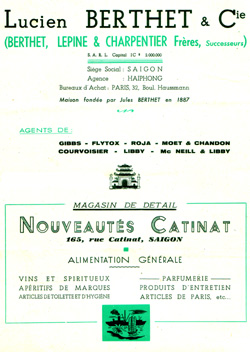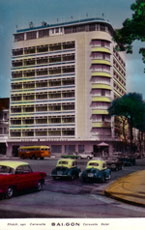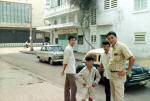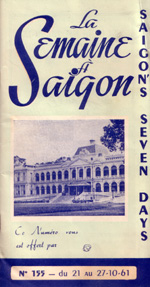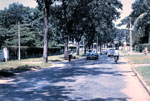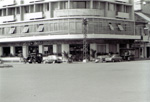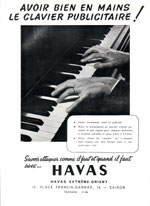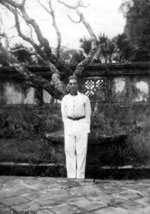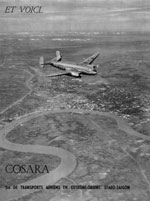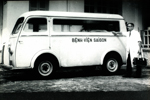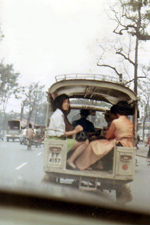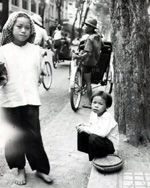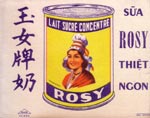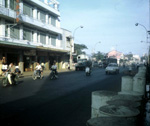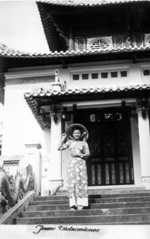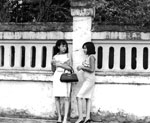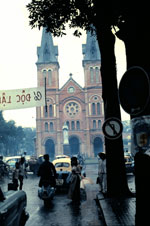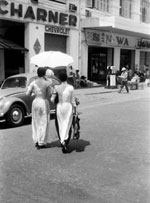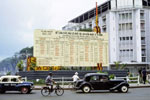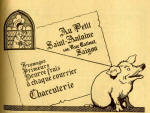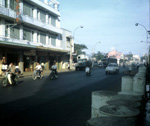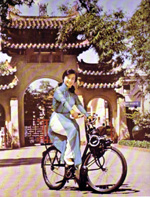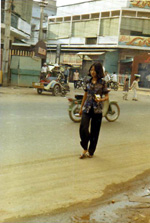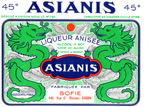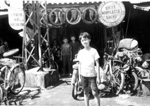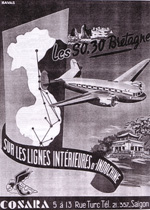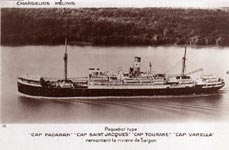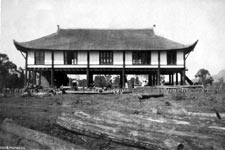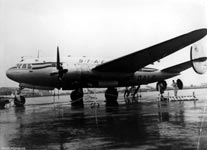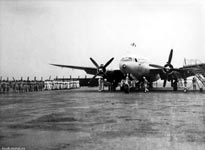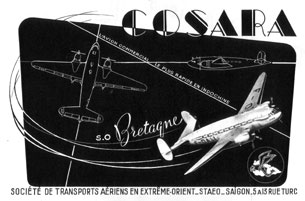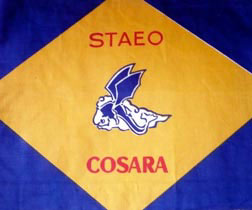

Cosara
An aviation company which will remain
the adventure of one man: Maurice LoubiГЁre
COSARA
P.B. 716 - Cable address : Cosara-Saigon
5 to 13, Turc Street
(now HГҙ HuГўn NghiГӘp )
Saigon
Turc Street is located near the Saigon River between the even side of Catinat Street and the Rigault de Genouilly Square.
Marseilles Saigon
On the steamer "Le Cap Varella"
In 1929 Maurice LoubiГЁre, a native of Marseilles, boarded the вҖңCap VarellaвҖқ, a steamer of the вҖңChargeurs RГ©unisвҖқ, a French Steamship company, to do his military service in Indochina.
He was assigned to the Colonial Artillery Regiment in Hanoi. He learned Vietnamese and then became an interpreter for the CAR.
After seventeen years in business with Socony-Safcat.

The Tonkin Pagodas
Standard Oil and the « Comptoirs GГ©nГ©raux de LвҖҷIndochineВ В» pulled off a masterstroke when he obtained by himself an order for a hundred « Berliet-GazoboisВ В» trucks for the CGI. At the time, gasoline was more than rationed and vehicles ran on charcoal gas and rice alcohol to replace petrol. The renewal of hostilities forced Maurice LoubiГЁre to leave the company to take up his post at the Colonial Artillery Regiment.
In September 1942 he started his own company:
"Les Comptiors des Industries Locales", a business providing supplies and food to the army troops.
Five years later, considering the events and difficulties in resupplying in a timely manner the troops scattered all over the country with fresh food, Maurice LoubiГЁre starts thinking about taking advantage of the numerous unused small airports built by the Japanese. He therefore plans to acquire an airplane for the transport of freight on demand.
On September 9th, 1947, he puts down his statutes to the Chamber of Commerce in Saigon and thus transforms his first business into a corporation with a capital of one hundred thousand piasters. He provides seventy-five thousand, and his associate, one of his Vietnamese friends, adds twenty-five thousand..
COSARA (Comptoirs Saigonnais de Ravitaillements) is born.
The offices are at Turc Street in Saigon.
The headquarters on Turc Street
Cosara
5 to 13, Turc Street
Saigon
Tel : CA.584, 21.357 and 21.131
This is one of the first civil aviation companies in Indochina to assure domestic lines over the rebellious territories.
September 1st, 1947, COSARA leases a first Junkers 52 from the STA (SociГ©tГ© Transatlantique AГ©rienne, operating in Africa but whose headquarters are in Paris). They obtain permission from the director of Civil Aviation in Indochina, Colonel Lafon, to operate an air transport service to haul freight on demand, resupply foodstuffs, shipping, and charter ships and river and air transport with an exception for passengers on the following lines:
- Saigon Soctrang, return trip
- Saigon Phnom-Penh, return trip
- Saigon Laos, transport of passengers is authorized without conditions.
The passenger hall of COSARA on Turc Street, Saigon
At yearвҖҷs end a second Ju52 is leased from the same company. STA acquires several shares in COSARA.
These Ju52вҖҷs are propeller-driven airplanes with a load capacity of two tons and their cruising speed is three hundred kilometers per hour.
COSARAвҖҷs trucks
The branch of the food resupply business to the troops stays busy with 5 trucks going full blast. Additionally, COSARA sets up road links between the city center and the airports for goods and travelers with 8 вҖңIsoblocвҖқ trucks, for which it is the sole agent in the Far-East:
"The Airplane on the Road", nice name for transportation.
The Airplane on the Road
A few months later, COSARA asks the High Commisioner for Civil Aviation to the permission to purchase two Dakotas due to the great demand for cargo transport. Permission is granted on 12/02/1948 on the condition that an Indochina branch be established so that the equipment would serve only the local economy. It was done!
The capital of COSARA increases to five hundred thousand piasters while retaining the Вҫ - Вј between Maurice LoubiГЁre and his associate.
The "В SociГ©tГ© Transatlantique AГ©rienne dвҖҷExtrГӘme-OrientВ " (STAEO) is born and becomes the aviation branch of COSARA.
Mr. LoubiГЁre is the manager while remaining the CEO of COSARA, General Girier, already the administrator of the STA, becomes the technical advisor to STAEO, and Meyer is the Chief Pilot. Ph. HoГ© remains the commercial manager.
For its STAEO branch, COSARA requests authorization to fly over Indochina, once again for freight and passengers. Colonel Charles Lafon, still the head of Civil Aviation in Indochina, grants the request. COSARA becomes the freight-hauler for STAEO.
One, then two and finally three DC-3 Dakotas are purchased from Swissair in Switzerland and STAEO pays off its purchases in two years with a percentage on flight hours.
COSARAвҖҷs fleet
On the left, a DC-3 Douglas-Dakota
On the right, a SO30 Bretagne
These DC-3вҖҷs have a huge potential compared to the Ju52вҖҷs. They can carry thirty-two passengers, can haul up to eight tons of freight, and are equipped with two Pratt & Whitney engines. Additionally, they can be completely stripped of their interior comfort features for troop transport.
All would be perfect if not for this interminable war...

They carry everything, full or empty baskets, all sorts of materials, fowl such as chickens, ducks, geese in cages and pigs on the hoof but with diapers if you please..., so as not to soil the floor with urine, and of course cereals вҖ“ rice, wheat, foodstuffs, coffee, and a lot of other bales of approximate content.
New stops appear on the route mapВ : Saigon вҖ“ Tourane вҖ“Hue вҖ“ Hanoi вҖ“ Phnom Penh вҖ“ Tranninh вҖ“ Hue - Soctrang.
COSARA remained a business of supplies and food for troops and branched out into public transportation on the Tan Son Nhut and Cholon with five "Isoblocs" for supplying armaments ships, four buses and four touring cars also are added to the already impressive park of "Airplanes of the Road".
The staff of both companies COSARA/STAEO is now quite numerous and the misdeeds of war arenвҖҷt helping things.
Mr. LoubiГЁre innovates by building houses reserved for them and their families. .
In 1949 COSARA builds an air operations base at Tan Son Nhut airport, with a stock of spare parts and a repair shop for the maintenance of its fleet. It moves its headquarters to Dalat, at No. 3, Graffeuil Avenue.
It becomes the contract supplier for the Chargeurs RГ©unis of the Merchant Marine as well as for the Commission des Ordinaires of Tourane. All shares of STA are bought back by COSARA which becomes the major stockholder in its companies (COSARA/STAEO).
The STAEO Company, still headquartered in Saigon, changes its status as a L.L.C. to a corporation. It also changes its denomination and becomes the Air Transport Company of the Far-East (SociГ©tГ© des Transports AГ©riens dвҖҷExtrГӘme-Orient). Its already-known logo, STAEO, is not changed, however its capital is changed and now exceeds two milllions six hundred thousand piasters (a piaster is worth seventeen francs at the time) and the distribution of shares includes Air France with this new status.
Surprisingly, itвҖҷs the COSARA logo which will be retained forever, as well as the headings on all mail whether concerning one or the other company, for the eight years of its existence in Indochina. .
Finally, after many, many requests, the authorization to transport passengers "officially" in addition to cargo is granted. They were doing it anyway, but "on the sly". A new air route appears: Saigon- Phnom Penh вҖ“ Soctrang вҖ“ PhanThiet вҖ“Tourane -Hue- Vientiane -Dalat.
Prince Savang Luang Prabang agrees to be a member of the board of STAEO to represent the Laotian group.
COSARA requires the services of Air France in the event of a shortage of its own planes. Air France has trouble assuring its connections, and COSARA would like to use the open slots, but the monopoly of the major company prevents this. In the end, admiral HГ©brard, representing Air France endorses COSARA for scheduled flights on nearly all the domestic routes in Indochina, except those said to be long-haul such as Saigon вҖ“ Hanoi, and Saigon вҖ“ Haiphong.
It is only as of 1950 that COSARA is able to use these two main routes.
The COSARA staff
On the left the crew of a COSARA airplane.
On the right, Maurice LoubiГЁre, white shirt, grey trousers (legs apart), jumping for joy upon delivery of his new SO30 airplane.

The war is always present and results in numerous wounded; COSARA provides its airplanes for the transportation of the wounded.
This is an excerpt of a letter that colonel CrГЁvecoeur sent to Maurice LoubiГЁre, which relates the tragic events in Indochina in these days of 1949, and speaks of the usefulness of the air transport companies in action:
вҖҰIn 1949 COSARA rendered a valuable service to the Expeditionary Corps, following an engagement in the vicinity of Soctrang, it evacuated a large number of wounded, two whole planeloads. When the reimbursement vouchers to were sent to you to cover the transportation expenses, you returned them to the Commander in Chief telling him that you did not wish to be paid for the transport of wounded soldiers, but simply wished to provide impartial assistance to the Expeditionary Corps and to show by this simple gesture that you wished to participate in their efforts and their sacrifices.
General Blaizot has asked me to express his thanks and the gratitude of the Expeditionary Corps...
Colonel de CrГЁvecoeur.

It is now 1950.
The COSARA-STAEO pair is classified 2nd among air transport companies and enjoys approval of both the public and the Asiatic community, and becomes more and more prosperous.
This awakens and exposes jealousies and latent controversies.
Especially when COSARA publishes, without awaiting ministerial decisions, an advertisement which highlights its new low rates for daily flights on the route coveted by Air France.
COSARA advertisement
Left : from 1951 to 1953 four new DC-3s will be added to COSARAвҖҷs fleet. But all goes very quickly, and the war is still on!
COSARA seeks aircraft with a greater speed than the Dakotas, since these are becoming scarce on the market!
COSARAвҖҷs airplanes as well as those of other airlines are requisitioned for troop transport.
COSARA is nominated for the Great Cross of the Legion of Honor military medal for services rendered:
"For transporting 230 military passengers from Saigon to Hanoi in 10 airplanes on 10, 11, 12 December 1951 with 27 passengers by DC-3".
In 1952 a COSARA DC-3 Dakota is shot down by the Viet Minh at Phan Thiet; there were only injuries.
At this time it is very difficult, if not impossible, to find DC-3 Dakotas in good condition on the market. COSARA obtains authorization to operate two SO30 Bretagne which were added to the fleet on 24 July, 1952.
Right : Cosara Add published in the Bottin phone book in 1951.
French-made, these aircraft are not favored by the airlines.
They are twin-engine, Pratt & Whitney, seating 43 passengers in two rows. They are pressurized, the epitome of luxury, the spacious holds have a capacity of 19 tons of payload and their speed is 400 Km/h.
Following negotiations with the director of SNCAZO and the approval of the Air Ministry, the contract is signed on 24 July, 1952. The crews and engineers of STAEO arrive from Saigon for training at Villacoublay.
All permits are been obtained: that of the Director of Civil Aviation in Indochina, the written approval of the High-Commissioner, that of the Ministers of Associated States, Transport, Finance, and Air, and stillвҖҰ
Publicity for these acquisitions is gigantic for the time and appears in numerous newspapers: Le Figaro, Match, France-Indochine, Les Ailes, France Outre-Mer, etc.
After having been deemedВ вҖңFit and good for serviceвҖқ by the pilots, the two SO30 head for Saigon, their home base, with a planned stop in Nice.
They are christened in this beautiful city by Empress Nam Phuong, wife of BГЈo DaГҜ, the last king of Annam and Emperor of Vietnam. The first SO30 gets the name Bac Hac, or White Swan, and the second Van Huong, or Pink Cloud. They then take off again and land in Athens, Damascus, New Delhi, and Calcutta. They arrive at their destination on August first.
These two airplanes bring a speed of transport that did not yet exist to Indochina, and of course create friction with other companies in the field.
From their first flight out of Tan Son Nhut, wham! Flight prohibition, some technical defects, it would seem. Passengers and cargo had to be unloaded. Indeed, Air Vietnam, which was just founded, enjoys the monopoly on domestic and long-haul routes, which short-circuits the immediate use of these flying monsters and challenges their profitability with at least one hundred flight hours a month. At first they will be used to the advantage of the military.
After many considerations and letters to the appropriate authorities, the Saigon-Hue-Hanoi traffic starts up again as well as all the other routes that COSARA formerly flew. They retain a third of all the domestic routes.

Many tons of freight are transported for the military and in 1953 alone over 47 flights are logged just for parachute drops.
Between 1953 and the end of 1954, two DC-3 Dakotas and five new SO30 Bretagnes are purchased by COSARA.
Harmony among airline operators in the territory of Indoichina remains a permanent issue.
During Operation "Cognac" 6000 people would be evacuated by COSARA.
After the Geneva accords signed on 20 July, 1954, Indochina is divided into two parts at the 17th parallel.
In 1955 COSARA ceases all activity. As a result of the country being divided in two the airlines can no longer function.
COSARA sells its DC-3вҖҷs to Air Vietnam and its SO30вҖҷs to the French Navy. It leaves behind a base of air operations at Tan Son Nhut which has become an International airport, and this base will be used by Air Vietnam.

The SO30 Bretagne
the fastest commercial aircraft in Indochina
Total number of aircraft for the COSARA-STAEO company:
- 2 Ju52
- 7 DC3 Dakotas
- 7 SO30 Bretagne
A total of 60,000 hours flown and 8,930,000 kilometers traveled.
- In 1947 it took 4 to 5 days to fly from Saigon to Paris, today it takes hardly a day.
- In 1949 it took 4 hours 15 min to fly from Saigon to Hanoi..
(per France Outre-mer july 1949)
- Maurice LoubiГЁre did not see Vietnam again until 1991, and returned completely disenchanted, unable to recognize the country he had so loved.
Monique LoubiГЁre

Saigon airport in 1949

All the facts of this text were found and drawn from official documents.
Archives of the Ministry of Civil and Military Aviation.
Archives of the Ministry of the Army
Overseas archives
Magazines « Le Fana de LвҖҷAviationВ В» (The Aviation Fan), Nos. 222, 223, and thos named in the text.
Photos, maps, and advertising from the personal collection of Monique LoubiГЁre
Photos of COSARA vehicles come from the National Overseas Archives in Aix en Provence.





